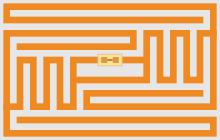 Global Information
Global InformationElectronic Product Code information
This article has multiple issues. Please help improve it or discuss these issues on the talk page. (Learn how and when to remove these template messages)
|

The Electronic Product Code (EPC) is designed as a universal identifier (using an idiosyncratic numerical code for each different commodity[1]) that provides a unique identity for every physical object anywhere in the world, for all time. The EPC structure is defined in the EPCglobal Tag Data Standard,[2] which is a freely available standard. The canonical representation of an EPC is a URI, namely the 'pure-identity URI' representation that is intended for use when referring to a specific physical object in communications about EPCs among information systems and business application software.
The EPCglobal Tag Data Standard also defines additional representations of an EPC identifier, such as the tag-encoding URI format and a compact binary format suitable for storing an EPC identifier efficiently within RFID tags (for which the low-cost passive RFID tags typically have limited memory capacity available for the EPC/UII memory bank). The EPCglobal Tag Data Standard defines the structure of the URI syntax and binary format, as well as the encoding and decoding rules to allow conversion between these representations. The EPC is designed as a flexible framework that can support many existing coding schemes, including many coding schemes currently in use with barcode technology. EPC identifiers currently support 7 identification keys from the GS1 system of identifiers, as well as a General Identifier and EPC identifiers that can be used for encoding supplies to the US Department of Defense.
EPCs are not designed exclusively for use with RFID data carriers. They can indeed be constructed based on reading of optical data carriers, such as linear bar codes and two-dimensional bar codes, such as Data Matrix symbols. The 'pure identity URI' canonical representation of an EPC is agnostic to the data carrier technology that was used to attach the unique identifier to the individual physical object.
The EPC is designed to meet the needs of various industries, while guaranteeing uniqueness for all EPC-compliant tags. Some of the existing GS1 identification keys (such as the Global Returnable Asset Identifier (GRAI)) already provide for unique identification of individual objects. However, the Global Trade Item Number (GTIN) only identifies the product type or stock-keeping unit rather than an individual instance of a particular product type. To ensure that an EPC always uniquely identifies an individual physical object, in the case of a GTIN, the EPC is constructed as a Serialised Global Trade Item Number (SGTIN) by combining a GTIN product identifier with a unique serial number.
Both the Universal Product Code and EAN-13 identifiers that are still found on many trade items can be mapped into a 14-digit GTIN identifier, by padding to the left with zero digits to reach a total of 14 digits. An SGTIN EPC identifier can therefore be constructed by combining the resulting GTIN with a unique serial number and following the encoding rules in the EPCglobal Tag Data Standard.
The EPC accommodates existing coding schemes and defines new schemes where necessary. Each coding scheme within the EPC identifier framework is distinguished through the use of a separate namespace. In the URI notations, this is indicated using a URI prefix such as urn:epc:id:sgtin or urn:epc:id:sscc
In the compact binary encoding of an EPC identifier, the namespace is instead indicated using a compact binary header (typically the first 8 bits of the binary encoding of an EPC identifier). The EPCglobal Tag Data Standard provides details of the URI prefixes and corresponding binary header values.
Low-cost passive RFID tags were designed to uniquely identify each item manufactured. In contrast, bar codes for trade items and consumer products have limited capacity and typically only identify the manufacturer and class of products. Although RFID tags are currently still more expensive than a simple optically readable label, they offer additional capabilities such as the ability to be read by radio waves, without requiring 'line of sight' between the reader or interrogator and the tag; this enables individual items within a large cardboard box (case) to be read without first unpacking each individual item from the box. Some RFID tags offer additional read/write user memory that could be used for storage of additional information, such as an expiry date or date of manufacture.
Plain text and barcoding are still useful in addition to the EPC tag, as liability obligations for the producer require durable and sufficiently fail-safe labels. Currently (2010) there are no applications in which RFID tags have completely replaced conventional labeling.
The EPC was the creation of the MIT Auto-ID Center, a consortium of over 120 global corporations and university labs. EPC identifiers were designed to identify each item manufactured, as opposed to just the manufacturer and class of products, as bar codes do today. The EPC system is currently managed by EPCglobal, Inc., a subsidiary of GS1. The specifications for the EPC identifiers can be found in the EPCglobal, Inc. Tag Data Standard, which is an open standard, freely available for anyone to download.
The Electronic Product Code is one of the industrial standards for global RFID usage, and a core element of the EPCglobal Network,[3] an architecture of open standards developed by the GS1 EPCglobal community. Most currently deployed EPC RFID tags comply with ISO/IEC 18000-6C for the RFID air interface standard.
- ^ "Electronic Product Codes (EPCs) - Explained". The Business Professor, LLC. Retrieved 2022-01-03.
- ^ "EPCglobal Tag Data Standard". www.epcglobalinc.org. Archived from the original on 9 November 2007. Retrieved 19 October 2022.
- ^ "EPCglobal Architecture Framework". www.epcglobalinc.org. Archived from the original on 1 August 2010. Retrieved 19 October 2022.